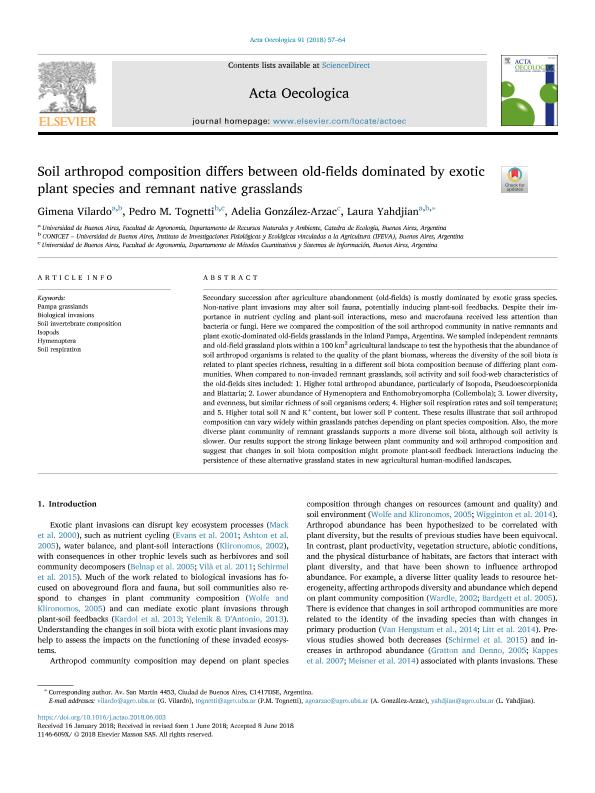Artículo
Soil arthropod composition differs between old-fields dominated by exotic plant species and remnant native grasslands
Fecha de publicación:
08/2018
Editorial:
Gauthier-Villars/Editions Elsevier
Revista:
Acta Oecologica
ISSN:
1146-609X
Idioma:
Inglés
Tipo de recurso:
Artículo publicado
Clasificación temática:
Resumen
Secondary succession after agriculture abandonment (old-fields) is mostly dominated by exotic grass species. Non-native plant invasions may alter soil fauna, potentially inducing plant-soil feedbacks. Despite their importance in nutrient cycling and plant-soil interactions, meso and macrofauna received less attention than bacteria or fungi. Here we compared the composition of the soil arthropod community in native remnants and plant exotic-dominated old-fields grasslands in the Inland Pampa, Argentina. We sampled independent remnants and old-field grassland plots within a 100 km2 agricultural landscape to test the hypothesis that the abundance of soil arthropod organisms is related to the quality of the plant biomass, whereas the diversity of the soil biota is related to plant species richness, resulting in a different soil biota composition because of differing plant communities. When compared to non-invaded remnant grasslands, soil activity and soil food-web characteristics of the old-fields sites included: 1. Higher total arthropod abundance, particularly of Isopoda, Pseudoescorpionida and Blattaria; 2. Lower abundance of Hymenoptera and Enthomobryomorpha (Collembola); 3. Lower diversity, and evenness, but similar richness of soil organisms orders; 4. Higher soil respiration rates and soil temperature; and 5. Higher total soil N and K+content, but lower soil P content. These results illustrate that soil arthropod composition can vary widely within grasslands patches depending on plant species composition. Also, the more diverse plant community of remnant grasslands supports a more diverse soil biota, although soil activity is slower. Our results support the strong linkage between plant community and soil arthropod composition and suggest that changes in soil biota composition might promote plant-soil feedback interactions inducing the persistence of these alternative grassland states in new agricultural human-modified landscapes.
Archivos asociados
Licencia
Identificadores
Colecciones
Articulos(IFEVA)
Articulos de INST.D/INV.FISIOLOGICAS Y ECO.VINCULADAS A L/AGRIC
Articulos de INST.D/INV.FISIOLOGICAS Y ECO.VINCULADAS A L/AGRIC
Citación
Vilardo, Gimena; Tognetti, Pedro Maximiliano; González Arzac, Adelia; Yahdjian, María Laura; Soil arthropod composition differs between old-fields dominated by exotic plant species and remnant native grasslands; Gauthier-Villars/Editions Elsevier; Acta Oecologica; 91; 8-2018; 57-64
Compartir
Altmétricas




